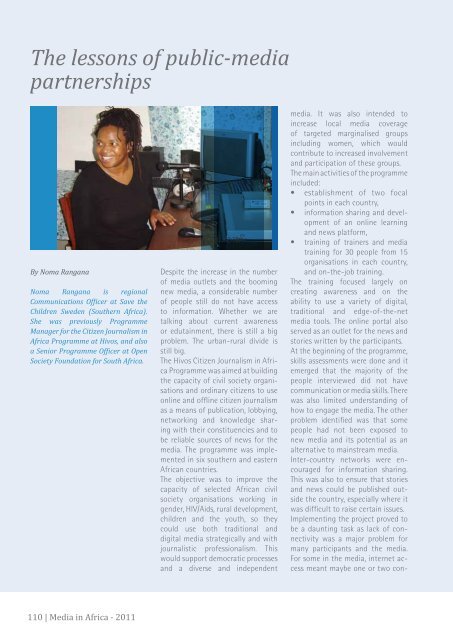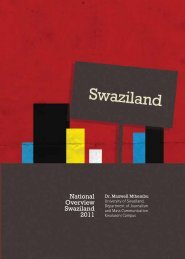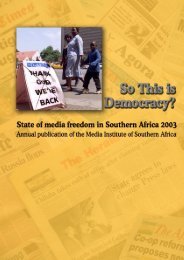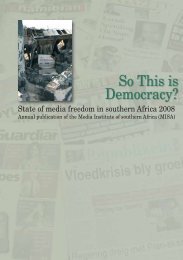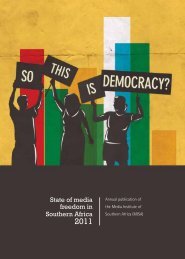Twenty years after the Windhoek Declaration on press freedom
Twenty years after the Windhoek Declaration on press freedom
Twenty years after the Windhoek Declaration on press freedom
You also want an ePaper? Increase the reach of your titles
YUMPU automatically turns print PDFs into web optimized ePapers that Google loves.
The less<strong>on</strong>s of public-media<br />
partnerships<br />
By Noma Rangana<br />
Noma Rangana is regi<strong>on</strong>al<br />
Communicati<strong>on</strong>s Officer at Save <str<strong>on</strong>g>the</str<strong>on</strong>g><br />
Children Sweden (Sou<str<strong>on</strong>g>the</str<strong>on</strong>g>rn Africa).<br />
She was previously Programme<br />
Manager for <str<strong>on</strong>g>the</str<strong>on</strong>g> Citizen Journalism in<br />
Africa Programme at Hivos, and also<br />
a Senior Programme Officer at Open<br />
Society Foundati<strong>on</strong> for South Africa.<br />
110 | Media in Africa - 2011<br />
Despite <str<strong>on</strong>g>the</str<strong>on</strong>g> increase in <str<strong>on</strong>g>the</str<strong>on</strong>g> number<br />
of media outlets and <str<strong>on</strong>g>the</str<strong>on</strong>g> booming<br />
new media, a c<strong>on</strong>siderable number<br />
of people still do not have access<br />
to informati<strong>on</strong>. Whe<str<strong>on</strong>g>the</str<strong>on</strong>g>r we are<br />
talking about current awareness<br />
or edutainment, <str<strong>on</strong>g>the</str<strong>on</strong>g>re is still a big<br />
problem. The urban-rural divide is<br />
still big.<br />
The Hivos Citizen Journalism in Africa<br />
Programme was aimed at building<br />
<str<strong>on</strong>g>the</str<strong>on</strong>g> capacity of civil society organisati<strong>on</strong>s<br />
and ordinary citizens to use<br />
<strong>on</strong>line and offline citizen journalism<br />
as a means of publicati<strong>on</strong>, lobbying,<br />
networking and knowledge sharing<br />
with <str<strong>on</strong>g>the</str<strong>on</strong>g>ir c<strong>on</strong>stituencies and to<br />
be reliable sources of news for <str<strong>on</strong>g>the</str<strong>on</strong>g><br />
media. The programme was implemented<br />
in six sou<str<strong>on</strong>g>the</str<strong>on</strong>g>rn and eastern<br />
African countries.<br />
The objective was to improve <str<strong>on</strong>g>the</str<strong>on</strong>g><br />
capacity of selected African civil<br />
society organisati<strong>on</strong>s working in<br />
gender, HIV/Aids, rural development,<br />
children and <str<strong>on</strong>g>the</str<strong>on</strong>g> youth, so <str<strong>on</strong>g>the</str<strong>on</strong>g>y<br />
could use both traditi<strong>on</strong>al and<br />
digital media strategically and with<br />
journalistic professi<strong>on</strong>alism. This<br />
would support democratic processes<br />
and a diverse and independent<br />
media. It was also intended to<br />
increase local media coverage<br />
of targeted marginalised groups<br />
including women, which would<br />
c<strong>on</strong>tribute to increased involvement<br />
and participati<strong>on</strong> of <str<strong>on</strong>g>the</str<strong>on</strong>g>se groups.<br />
The main activities of <str<strong>on</strong>g>the</str<strong>on</strong>g> programme<br />
included:<br />
• establishment of two focal<br />
points in each country,<br />
• informati<strong>on</strong> sharing and development<br />
of an <strong>on</strong>line learning<br />
and news platform,<br />
• training of trainers and media<br />
training for 30 people from 15<br />
organisati<strong>on</strong>s in each country,<br />
and <strong>on</strong>-<str<strong>on</strong>g>the</str<strong>on</strong>g>-job training.<br />
The training focused largely <strong>on</strong><br />
creating awareness and <strong>on</strong> <str<strong>on</strong>g>the</str<strong>on</strong>g><br />
ability to use a variety of digital,<br />
traditi<strong>on</strong>al and edge-of-<str<strong>on</strong>g>the</str<strong>on</strong>g>-net<br />
media tools. The <strong>on</strong>line portal also<br />
served as an outlet for <str<strong>on</strong>g>the</str<strong>on</strong>g> news and<br />
stories written by <str<strong>on</strong>g>the</str<strong>on</strong>g> participants.<br />
At <str<strong>on</strong>g>the</str<strong>on</strong>g> beginning of <str<strong>on</strong>g>the</str<strong>on</strong>g> programme,<br />
skills assessments were d<strong>on</strong>e and it<br />
emerged that <str<strong>on</strong>g>the</str<strong>on</strong>g> majority of <str<strong>on</strong>g>the</str<strong>on</strong>g><br />
people interviewed did not have<br />
communicati<strong>on</strong> or media skills. There<br />
was also limited understanding of<br />
how to engage <str<strong>on</strong>g>the</str<strong>on</strong>g> media. The o<str<strong>on</strong>g>the</str<strong>on</strong>g>r<br />
problem identified was that some<br />
people had not been exposed to<br />
new media and its potential as an<br />
alternative to mainstream media.<br />
Inter-country networks were encouraged<br />
for informati<strong>on</strong> sharing.<br />
This was also to ensure that stories<br />
and news could be published outside<br />
<str<strong>on</strong>g>the</str<strong>on</strong>g> country, especially where it<br />
was difficult to raise certain issues.<br />
Implementing <str<strong>on</strong>g>the</str<strong>on</strong>g> project proved to<br />
be a daunting task as lack of c<strong>on</strong>nectivity<br />
was a major problem for<br />
many participants and <str<strong>on</strong>g>the</str<strong>on</strong>g> media.<br />
For some in <str<strong>on</strong>g>the</str<strong>on</strong>g> media, internet access<br />
meant maybe <strong>on</strong>e or two c<strong>on</strong>-


